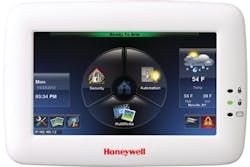Consumer expectations changing alarm technology
Just as the way people communicate and interact with the world around them has changed rapidly with innovations in mobile technology over the past several years, so to have the ways consumers view and use security systems. Alarm technology and dealers have subsequently had to change with the times to offer customers a more robust experience. Being able to integrate multiple home technologies, such as lights, door locks and temperature control into the alarm control panel are now the norm and not the exception.
In an online conference with members of the media this week, Scott Harkins, president, Honeywell Security Products Americas, discussed these and other trends and how the company is helping the industry meet this demand for more user-intuitive products. “Consumer behavior and expectations are changing dramatically and have, in fact, changed dramatically over the past several years,” Harkins explained.
Though the market penetration for residential security systems has been around 18 to 20 percent for a number of years, Harkins believes these recent advances in technology offer the industry a lot of growth opportunities. “I think this penetration can grow to 30 or 40 percent and that is ultimately our goal,” he said. “We have to deliver what the homeowner expects.”
According to Harkins, there are six consumer technology trends currently having an impact on the residential security market. These include:
- The proliferation of smartphones. Harkins said that the way smartphones have taken command of the market is “unbelievable” and that their prevalence and connectivity with alarm systems is only going to grow.
- Pervasiveness and expansion of broadband Internet connectivity. Statistics show that the majority of Internet subscribers have broadband connectivity. However, according to Harkins, what is changing with regards to broadband is not the addition of more end-users, but rather the size of the pipeline which is getting larger and larger. As a result, Harkins said industries like security are finding ways to fill it up.
- Continued push for touchscreens. Harkins attributes the advent of touchscreens for alarm panels with how prevalent cell phones have made the technology in people’s everyday lives. And while the technology has been around for some time in cell phones, Harkins said it is still relatively new to alarms, but the expectations of consumers demand that the security industry adapt.
- Technology integration. Though integration of security systems in commercial installations is not new, there is now more a push for this capability in the residential market as the concept of the connected home has begun to take off. Subsequently, more consumers are beginning to expect their security system to integrate with their other Internet-enabled devices in the home.
- Prevalence of cloud services. Harkins said that cloud services could be a “game changing opportunity” for alarm dealers and technology providers alike as it enables companies to offer their customers more services and thus increase their recurring monthly revenue (RMR). “I think we are at the beginning of a significant transition,” Harkins said.
- Changing the user experience. From the perspective of a hardware manufacturer, Harkins said that they have to think about user experience – both in terms of how easy it is for the dealer to setup and install, as well as what it is like for the homeowner or end-customer to use. Harkins said that Honeywell recently conducted consumer research to gauge the expectations of their users and some of the answers they got were surprising. Perhaps the biggest surprise, according to Harkins, is that while consumers like the remote access capabilities of smartphones, they don’t want to be completely dependent on them when it comes to interacting with their alarm systems. Not only do consumers want a “central command center” when it comes to an alarm system, they also want one that is really easy to use.
On the commercial side, Harkins said that he’s seen a lot of consumer trends bleed into this space, such as the expectation to be able to be remotely control a security system. Mobile platforms and applications that provide remote access anytime and anywhere are now becoming more prevalent in commercial security applications.
Aside from these trends, Harkins said another thing that is impacting the industry in a big way is the new entrants into the residential security market, such as the big telecommunications and cable providers. Though some may see these new entrants as a threat, Harkins believes that they will ultimately prove to a good thing for the security industry because they are using their sizable marketing budgets to push these aforementioned “lifestyle feature” (security system integration with lights, HVAC, etc.), which will increase demand and educated more consumers.
Attendees at ISC West 2013 can expect to see a host of new products from Honeywell based on these trends. Click here to read more about these new offerings, which will include new versions of the LYNX Touch 5100 panel and the Tuxedo Touch touchscreen controller with Honeywell Total Connect, MAXPRO Cloud 3.0 hosted video service, MAXPRO NVR 2.5, and the Pro-Watch 4.1 security management platform.
About the Author
Joel Griffin
Editor-in-Chief, SecurityInfoWatch.com
Joel Griffin is the Editor-in-Chief of SecurityInfoWatch.com, a business-to-business news website published by Endeavor Business Media that covers all aspects of the physical security industry. Joel has covered the security industry since May 2008 when he first joined the site as assistant editor. Prior to SecurityInfoWatch, Joel worked as a staff reporter for two years at the Newton Citizen, a daily newspaper located in the suburban Atlanta city of Covington, Ga.

